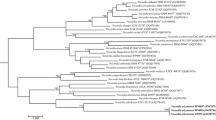Abstract
Nocardia beijingensis, a recently established new species, is an isolate from soil in China. During our taxonomic studies on 450 nocardial clinical isolates in Thailand and Japan, 17 strains from Thailand and 1 strain from Japan were found to have a similar physiological characteristic to those of N. beijingensis, such as a drug susceptibility pattern to three antimicrobial agents. Our phylogenetic studies on these 18 strains by 16S rRNA gene sequence analysis confirmed that these strains belong to N. beijingensis species. Phylogenetically, these newly isolated N. beijingensis strains were found to be classified into two distinct clades: one is a Japanese clade and other is a Chinese clade, including a reference strain and 17 Thai strains. This is the first report of human infection due to N. beijingensis strains, and we propose that the bacterium be categorized as an opportunistic infectious group regardless of its original isolation from soil.
Similar content being viewed by others
References
McNeil MM, Brown JM. The medically important aerobic actinomycetes: Epidemiology and microbiology. Clin Microbiol Rev 1994; 7: 357–417.
Gordon RE, Barnett DA, Handerhan JE, Pang, CHN. Nocardia coeliaca, Nocardia autotrophica, and the nocardin strain. Int J Syst Bacteriol 1974; 24: 54–63.
Goodfellow M. Nocardia and related genera. In: Balows A, Duerden BI, eds. Topley and Wilson's Microbiology and Microbial Infections, 9th edn, Vol. 2, Systematic Bacteriology, London: Arnold, 1997; 463–489.
Boiron P, Provost F, Chevrier G, Dupont B. Review of nocardial infections in France 1987 to 1990. Eur J Clin Infect Dis 1992; 11: 709–714.
Beaman BL, Beaman L. Nocardia species: Host-parasite relationship. Clin Microbiol Rev 1994; 7: 213–264.
Poonwan N, Kusum M, Mikami Y, Yazawa K, Tanaka Y, Gonoi Hasegawa T, Konyama K. Pathogenic Nocardia isolated from clinical specimens including those of AIDS patients in Thailand. Eur J Epidemiol 1995; 11: 507–512.
Javaly K, Horowitz HW, Wormser GP. Nocardiosis in patients with human immunodeficiency virus infection. Medicine (Baltimore) 1992; 128–138.
Cross T, Rowbotham TJ, Mishustin EN, Tepper EZ, Antoineportaeles F, Schaal KP, Bickenbach H. The ecology of nocardioform actinomycetes. In: Goodfellow M, Brownell GH, Serrano JA, eds. The Biology of the Nocardiae, London: Academic Press, 1976; 337–371.
Wang L, Zhang Y, Lu Z, Shi Y, Liu Z, Maldonado L, Goodfellow M. Nocardia beijingensis sp. nov., a novel isolate from soil. Int J Syst Evol Microbiol 2001; 51: 1783–1788.
Schaal KP. Identification of clinically significant actionomycetes and related bacteria. In: Goodfellow M, Minnikin DE, eds. Chemical Methods in Bacterial Systematics. London: Academic Press, 1985; 359–381.
Mikami Y, Yazawa K. Susceptibility patterns of pathogenic Nocardia to some selected antimicrobial agents and their usefulness in the identification work. Bull of JFCC 1989; 5: 89–95.
Tamura M, Watanabe K, Mikami Y, Yazawa K, Nishiumura K. Molecular characterization of new clinical isolates of Candida albicans and C. dubliniensis in Japan: Analysis reveals a new genotype of C. albicans with group 1 intron. J Clin Microbiol 2001; 39: 4309–4315.
Saitou N, Nei M. The neighbor-joining method: A new method for reconstructing phylogenetic trees. Mol Biol Evol 1987; 4: 406–425.
Thompson JD, Higgins DG, Gibson TJ. CLUSTAL W: Improving the sensitivity of progressive multiple sequence alignment through sequence weighting, position specific gap penalties and weight matrix choice. Nucleic Acids Res 1994; 22: 4673–4680.
Shimizu A, Ishikawa O, Nagai Y, Mikami Y, Nishimura K. Primary cutaneous nocardiosis due to Nocardia nova in a healthy woman. Brit J Dermatol 2001; 145: 154–156.
Furumoto H, Sasaki T, Tatebayashi K, Shimizu T, Mikami Y. Profound skin infection with bone involvement due to Nocardia asteroids in a patient with myelodysplastic syndrome. J Dermatol 2001; 28: 582–583.
Author information
Authors and Affiliations
Corresponding author
Rights and permissions
About this article
Cite this article
Kageyama, A., Poonwan, N., Yazawa, K. et al. Nocardia beijingensis, is a Pathogenic Bacterium to Humans: The First Infectious Cases in Thailand and Japan. Mycopathologia 157, 155–161 (2004). https://doi.org/10.1023/B:MYCO.0000020588.60081.37
Issue Date:
DOI: https://doi.org/10.1023/B:MYCO.0000020588.60081.37




